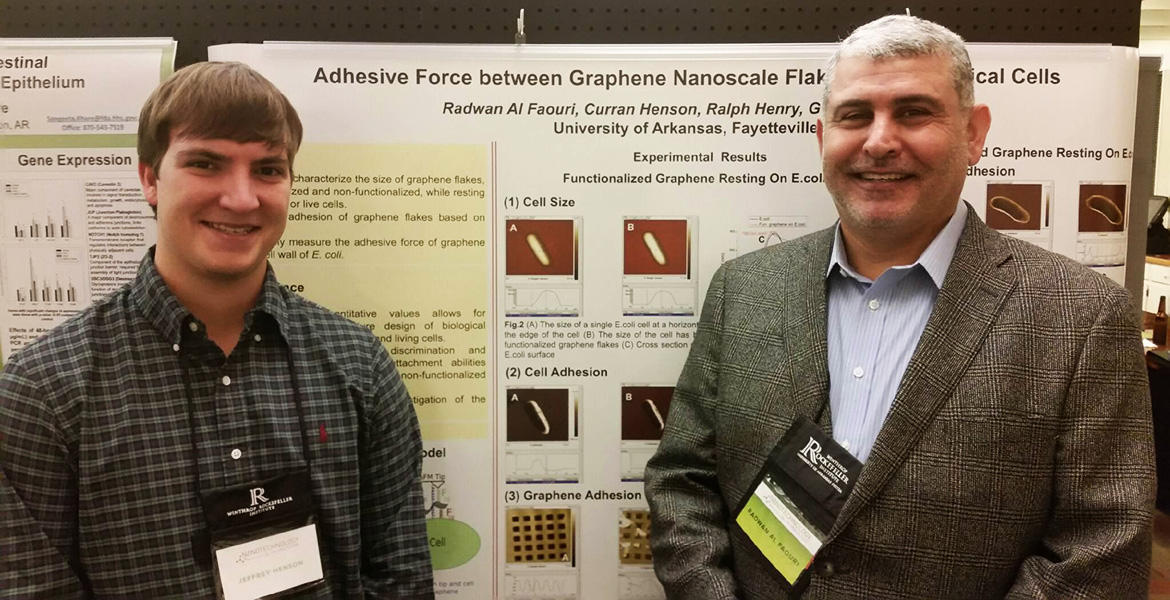
Henson and Dr. Radwan Al-Faouri stand before a poster depicting the graphene research they presented at the conference.
On December 2, 2015, University of Arkansas biomedical engineering student Curran Henson attended the Winthrop Rockefeller Nanotechnology for Healthcare Conference. While there, he helped Dr. Radwan Al-Faouri (shown above) present graphene research. Below, Henson offers his reflections on the conference:
The Winthrop Rockefeller Nanotechnology Conference was a huge success in my eyes. It was a very engaging experience in which I got to learn about some of the fascinating advances related to the field of nanotechnology in healthcare. The potential that nanotechnology has to change the methods by which healthcare occurs, mainly in the area of cancer treatment and oncological practices, is truly amazing to me.
The most interesting and engaging presentations that I attended were those that discussed different techniques of using nanoparticles in cancer therapy. One of the best talks came from our very own Dr. Jensen, in which he discussed the use of nanomaterials to help regenerate cardiovascular tissue. Another talk that I found fascinating was a presentation given by Dr. Berlin of the Beckman Research Institute, City of Hope California. This talk was about the use of nanoparticles to target and deliver drugs in order to treat Brain Cancer; as he described it, carbon nanotubes were used to deliver immunostimulatory molecules that helped to cause reduction in tumor size, and an increase in the migration of immune cells to the affected area. This was one of favorite talks because the results shown from animal testing trials in mice were so positive; these positive results led me to the realization that this type of therapy could one day revolutionize the way cancer is treated.
On a personal level, this conference was a blessing because it provided me with the ability to understand what the real world of research is like. I would most definitely attend another conference like this because of the great opportunity to see what is being done in the career I may pursue. Also, Dr. Wolchok warned me that they feed you very good at conferences and he sure wasn’t wrong—that in itself is another reason worth going! Also, the 1996 Nobel Prize winner for Chemistry, Sir. Harold Kroto was there. Getting to speak with him was a very rewarding experience; if only I had gotten pictures!
Presenting research for the first time was a little nerve-wracking, but after the butterflies in my stomach settled, it was very rewarding. Having the chance to interact with professionals that are interested in my work was an excellent networking opportunity, and presenting my research was empowering. It made me proud to share an achievement I’ve accomplished during my academic career at the U. of A. As such, I would like to thank the University of Arkansas Biomedical Engineering Department for providing me with funding to attend this conference. I would also like to give special acknowledgment to Dr. Gregory Salamo, and Dr. Radwan Al Faouri, for giving me the opportunity to attend, and the chance to present research conducted in their lab.
Speaking broadly, conferences like this one give attendees the opportunity to stay engaged in current work in the field of nanotechnology, and to make connections with academics across the country. Moving forward, I believe it should be required as part of the undergraduate curriculum that all U. of A. students attend a conference before graduation. Conferences offer students the opportunity to really see what is out there, and get a taste of the current advancements and research being done in their field of study.
—Curran Henson
